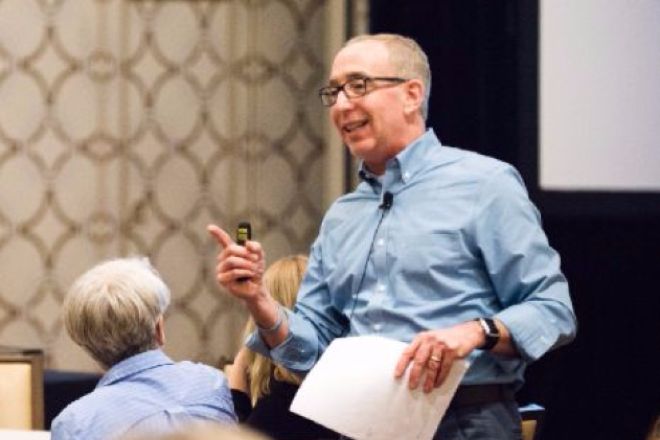Article by Leah Thayer, with a webcast conversation between Teibel and Jeffrey Shields, FASAE, CAE
Ideas for better ways to tackle core challenges can come from anywhere on an independent school campus, including offices or functional areas outside your usual day-to-day. Howard Teibel, an educational change management consultant who is leading a “deep dive” session at the 2017 NBOA Annual Meeting, says one of the best routes to greater productivity and efficiency begins with breaking down organizational silos.
Above: Watch this video conversation between Teibel and NBOA President & CEO Jeff Shields about business officers as change agents, along with opportunities at the 2017 NBOA Annual Meeting.
Consider tuition billing, said Teibel (shown in photo at top at the 2016 NBOA Annual Meeting). While this responsibility will always lie with the business office, input from IT and HR departments, along with parents and students, might lead to changes that transform the perception and ease of tuition billing systems. The problem now is that “We don’t ask,” Teibel said. “We assume we know what our customers want.” This constrains our thinking into mental silos that keep finance within finance, enrollment within enrollment, HR within HR, IT within IT and so on.
Teibel explored the risks of siloed thinking in a recent workshop at the University of Colorado Boulder. Kelly Fox, the school’s CFO, had been inspired by a book, Creativity, Inc., by Ed Catmull, about workplace creativity at Pixar Animation Studios. The book explores seven “big ideas” for innovation and collaboration:
- Share early efforts. Show incomplete work to a team, and iterate early.
- Take research trips.
- Set limits.
- Integrate technology and art.
- Conduct short experiments.
- Learn to see what isn’t there.
- Insist on postmortems.
- Design opportunities for continuous learning.
Working with Teibel, Fox brought together 50 leaders from the university’s administrative and finance departments to learn how they might apply Pixar’s methods at the university. The two went on to lead a second retreat, with 140 additional staff members from these departments, followed by asking for proposals to address campus areas of need. Cross-functional teams submitted more than 60 proposals outlining how the school might demolish certain silos in order to improve everything from student pipelines to tuition classification.
In a phone interview with Net Assets, Teibel said, “The challenge is that you’re essentially inviting criticism” by proposing new methods. “You need to be able to trust, and you need to have leaders who admit that not only do they not have all the answers, but their team may not either. It inspired conversations around ‘How can we be innovative with other people we don’t normally work with?’”
Teibel surmises that this type of cross-functional collaboration could inspire many improvements in independent schools, similar to the collaboration in a university environment. He cites scheduling as an example. “Get people across disciplines (HR, academics, IT, finance) to learn the mechanisms, recognize the opportunity to experiment, and listen to points of view outside their areas,” he said. “It’s about broadening the perspective beyond those who are stuck in thinking ‘things have to be done this way.’”
- Read Teibel’s article on NACUBO.org, Loosen the Grip on Silo Thinking
- Listen to Teibel’s podcast, Finding Inspiration on the Outside – Bringing Innovation to Higher Ed
- Learn about Teibel Education Consulting's work with independent schools
- Read Jeff Shields reflections on Teibel’s strategies in The Business Officer’s Dilemma



